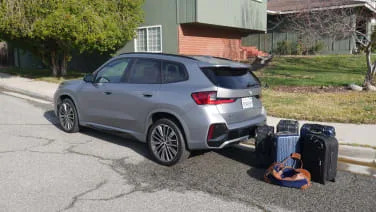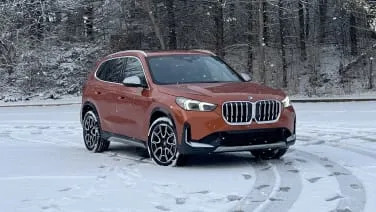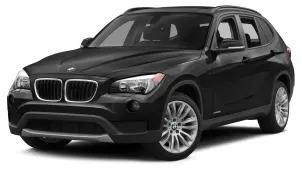xDrive 35i 4dr All-Wheel Drive Sports Activity Vehicle
2013 BMW X1
Popular in Europe after going on sale there three years ago, the BMW X1 subcompact SUV is now available in the U.S. Based on the BMW 1 Series sedan, the X1 is BMW's smallest SUV, smaller than the X3. From a certain perspective, the BMW X1 makes fiscal sense, because it makes the X Series available to buyers who lust for a BMW crossover but don't feel they can step up to the price of an X3 or X5. The base price gap between X1 and X3 is about $8,000, but the X3 comes standard with all-wheel drive, whereas the base X1 sDrive28i is rear-wheel drive. (The 2013 BMW X3 xDrive28i starts at $38,850 MSRP, while a 2013 BMW X3 xDrive28i retails for $32,350.)
This is not an economic chasm. Adding just a couple option groups to an X1 can put you well into X3 territory. Our well-equipped BMW X1 xDrive28i, which retailed for $45,095 as tested, makes a strong case in point. And stepping up to a loaded X1 xDrive35i, with its 300-horsepower 3.0-liter inline six-cylinder turbo engine and all-wheel drive, can swell the total to $50,000 and beyond.
But if the marketing perspective may not make as much financial sense to you as it does to BMW insiders, the X1 makes sense in other ways. Based on the solid architecture that supports the 1 Series sedan (derived from the last generation 3 Series), with the same wheelbase as the 3 Series station wagon, the X1 offers about the same interior volume as the wagon, even though it's 2.1 inches shorter overall.
BMW X1 dimensions are substantially tidier than those of the X3, making the X1 handier in urban operating conditions, and of course lighter than its bigger cousin, which pays off at the scales and the gas station. Even equipped with all-wheel drive, the X1 weighs about 300 pounds lighter, and it delivers a decisive 5 mpg edge in EPA highway fuel economy ratings.
Commonality with the 1 Series continues under the X1's hood, with two engine options, both turbocharged. The standard engine employed by the BMW X1 sDrive28i and X1 xDrive28i, is a 2.0-liter four-cylinder, rated for 240 horsepower and 260 pound-feet of torque. Fuel economy is an EPA-estimated 24/34 mpg City/Highway. BMW says it can accelerate from 0 to 60 mph in 6.2 seconds.
The upgrade is the smooth and potent 3.0-liter twin turbo six-cylinder, used by the BMW X1 xDrive35i and rated at 300 horsepower at 5800 rpm, 300 pound-feet of torque at 1300-5000 rpm. It's EPA-rated at 18/27 mpg City/Highway. BMW says it can accelerate from 0 to 60 mph in just 5.3 seconds.
The four-cylinder is paired with an 8-speed automatic transmission, which includes manual shifting, eco, and auto stop-start modes; the 3.0-liter transmits its power through the older 6-speed automatic.
All-wheel drive uses BMW's thoroughly developed xDrive system used on the BMW X1 xDrive 28i and BMW X1 xDrive35i. The BMW sDrive28i is rear-wheel drive.
Like the other BMW SUVs, the X1 …
Full Review
Full Review
From a certain perspective, the BMW X1 makes fiscal sense, because it makes the X Series available to buyers who lust for a BMW crossover but don't feel they can step up to the price of an X3 or X5. The base price gap between X1 and X3 is about $8,000, but the X3 comes standard with all-wheel drive, whereas the base X1 sDrive28i is rear-wheel drive. (The 2013 BMW X3 xDrive28i starts at $38,850 MSRP, while a 2013 BMW X3 xDrive28i retails for $32,350.)
This is not an economic chasm. Adding just a couple option groups to an X1 can put you well into X3 territory. Our well-equipped BMW X1 xDrive28i, which retailed for $45,095 as tested, makes a strong case in point. And stepping up to a loaded X1 xDrive35i, with its 300-horsepower 3.0-liter inline six-cylinder turbo engine and all-wheel drive, can swell the total to $50,000 and beyond.
But if the marketing perspective may not make as much financial sense to you as it does to BMW insiders, the X1 makes sense in other ways. Based on the solid architecture that supports the 1 Series sedan (derived from the last generation 3 Series), with the same wheelbase as the 3 Series station wagon, the X1 offers about the same interior volume as the wagon, even though it's 2.1 inches shorter overall.
BMW X1 dimensions are substantially tidier than those of the X3, making the X1 handier in urban operating conditions, and of course lighter than its bigger cousin, which pays off at the scales and the gas station. Even equipped with all-wheel drive, the X1 weighs about 300 pounds lighter, and it delivers a decisive 5 mpg edge in EPA highway fuel economy ratings.
Commonality with the 1 Series continues under the X1's hood, with two engine options, both turbocharged. The standard engine employed by the BMW X1 sDrive28i and X1 xDrive28i, is a 2.0-liter four-cylinder, rated for 240 horsepower and 260 pound-feet of torque. Fuel economy is an EPA-estimated 24/34 mpg City/Highway. BMW says it can accelerate from 0 to 60 mph in 6.2 seconds.
The upgrade is the smooth and potent 3.0-liter twin turbo six-cylinder, used by the BMW X1 xDrive35i and rated at 300 horsepower at 5800 rpm, 300 pound-feet of torque at 1300-5000 rpm. It's EPA-rated at 18/27 mpg City/Highway. BMW says it can accelerate from 0 to 60 mph in just 5.3 seconds.
The four-cylinder is paired with an 8-speed automatic transmission, which includes manual shifting, eco, and auto stop-start modes; the 3.0-liter transmits its power through the older 6-speed automatic.
All-wheel drive uses BMW's thoroughly developed xDrive system used on the BMW X1 xDrive 28i and BMW X1 xDrive35i. The BMW sDrive28i is rear-wheel drive.
Like the other BMW SUVs, the X1 …
Hide Full Review
Retail Price
| Engine | 3.0L I-6 |
| MPG | 18 City / 27 Hwy |
| Seating | 5 Passengers |
| Transmission | 6-spd w/OD |
| Power | 300 @ 5800 rpm |
| Drivetrain | all wheel |





